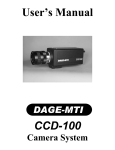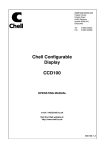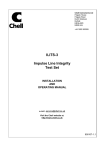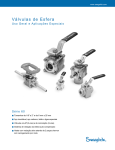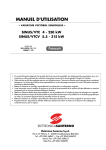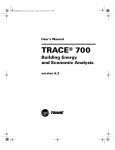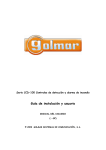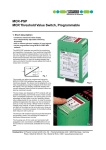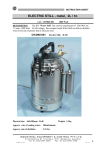Download MOBILE GAS SAMPLING UNIT OPERATING INSTRUCTIONS
Transcript
MOBILE GAS SAMPLING UNIT OPERATING INSTRUCTIONS SEVERN SCIENCE LIMITED Unit 8, Brunel Way Thornbury Bristol BS35 3UL March 2005 Publication ref: 2IZ245-1 CONTENTS Section Title 1 Introduction 2 Principle 3 Description General Assembly Filter Unit 3.1 3.2 4 Operating Instructions 5 Alarms 6 Routine Maintenance Gas Sampling Pump Filter Unit 6.1 6.2 Appendix 1 List of drawings Appendix 2 Associated Documents Appendix 3 Gas correction factor 1. INTRODUCTION The mobile gas sampling unit has been designed and manufactured to meet the requirements of xxxxxx Power Station. 2. PRINCIPLE The instrument is used to extract a sample of stack gas when connected to a sampling probe. The sample is drawn through a combined filter / activated carbon container to remove particulate and radioactive iodine species. The sample flow rate is regulated by a mass flow controller, which automatically compensates for changes in system pressure. The pump is turned on and off manually to start and finish sampling. After an appropriate volume (mass) of gas has been sampled, the particulate material and activated carbon granules are analysed for their radioactivity from which the total burdens of particulates and iodine species released to the environment can be calculated. 3. DESCRIPTION 3.1 General Assembly The sampling equipment is mounted in a mobile cubicle with removable front and rear panels. Heavy-duty castors (two swivel and lockable, two fixed) are fitted to the base. The filter unit is easily accessible from the front of the equipment via a hinged, lockable Perspex door. Inlet and outlet connections protrude from the top panel, with the inlet connection (1/2” swagelock quick connect, male) positioned directly above and in line with the filter unit and isolation valve. A mains isolator is mounted on the right hand side panel. The front control panel comprises a flow controller / display, a pump on / off button, fault and power indicators, buzzer and mute control. The pump is mounted in the base of the unit together with the mass flow controller. The unit operates from a power source of 110 volt 50Hz. The flow diagram for the system is detailed in drawing 8246 and drawings 8258 shows the wiring diagram. 3.2 Iodine filter unit (drawing 8264A1A) The iodine filter unit is dismounted by unscrewing the knurled ring and placing the lower half of the filter body on the bracket below the unit. This allows access to the filter paper grilles and the activated charcoal container. 4. OPERATION (see flow diagram 8246) 4.1 Fill the activated carbon container and place in the lower half of the filter unit. Place filter paper grilles above the container and assemble unit in accordance with drawing 8264A1A by connecting the upper and lower components using the knurled clamping ring. 4.2 Check that the gas inlet and extract connections have been fully secured between the probe and the extract respectively. 4.3 Connect the unit to a 110-volt 50Hz power source and turn on the mains isolator. The power indicator will illuminate. 4.4 Set the flow rate set point (on the CCD100 controller) by following the instructions below: a) Press the ‘Mode’ button b) Press the horizontal arrow to select the required digit (flashing) c) Select the desired flow rate using the vertical arrow. d) Press the ‘Zero’ button to revert to normal operational mode Note: The flow rate set point has to be re-set every time the unit is powered up. 4.5 Open the inlet isolation valve SS-63TS8 4.6 Press the ‘pump start’ button and note the time. At the end of the test, press the ‘pump stop’ button and note the time. To remove the sample: 4.7 Open the front Perspex door and close valve SS-63TS8 4.8 Open the filter unit by unscrewing the knurled nut and allow the bottom half of the unit to be detached from the top section. 4.9 Remove the carbon container and filter paper for examination by the appropriate radioactive counting techniques. 5. ALARMS The flow controller has two user adjustable alarm set points. These are factory configured as follows: Flow rate set point Low flow warning 60l/min 57l/min (the alarm warning will activate if the flow drops to 57l/min. In this state, the alarm indicator on the front panel will illuminate and the buzzer will activate. The buzzer can be turned off by pressing the ‘mute’ button. The alarm is non-latching. Low flow alarm 54l/min (if the flow rate drops to 54l/min, the alarm indictor will illuminate and the pump will stop (the test is aborted). In this state, the pump indicator is illuminated even though the pump has stopped. To reset, press pump stop. Note: If the flow rate set point is changed, the alarm set points must also be changed, as follow: a) Press the ‘Mode’ button until SPH1 (low flow warning) is displayed b) Press the horizontal arrow to select the required digit (flashing) c) Select the desired flow rate using the vertical arrow. d) Press the ‘Mode’ button until SPH2 (low flow alarm) is displayed e) Press the horizontal arrow to select the required digit (flashing) f) Select the desired flow rate using the vertical arrow. g) Press the ‘Zero’ button to revert to normal operational mode Note: There are a number of other user configurable functions on the flow controller that are not used for this application. These settings should not be changed. The factory default values are given below: SPL1 SPL2 HH HL CAL DP 0.0 0.0 0.0 0.0 100.0 1 decimal place 6. ROUTINE MAINTENANCE The unit will require little by way of maintenance apart from routine checks in accordance with details provided below. 6.1 Gas Sampling Pump Maintenance requirements for the pump are limited and are detailed in the manufacturers' literature. 6.2 Filter Unit The maintenance requirements of the iodine filter unit are limited to periodic replacement of O-rings. APPENDIX 1 LIST OF DRAWINGS 8258 Wiring Diagram 8246 Flow Diagram 8264A1A Filter Unit APPENDIX 2 ASSOCIATED DOCUMENTS VTE8 Vacuum Pump CCD100 Flow controller / display HFC-203 Mass flow controller APPENDIX 3 GAS CORRECTION FACTOR The HFC-203 Mass flow controller is calibrated with dry nitrogen. A correction factor must be applied to flow rate measurements if the equipment is used with gases other than nitrogen. In the case of carbon dioxide, the correction factor is 0.7526. Further details are included with this appendix.






